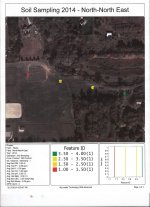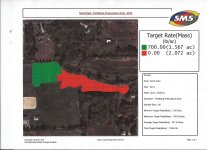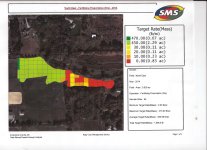Here is a satellite image which may help explain the situation better. This satellite image was obtained in the fall of 2012. It was approximately 3 months after we had taken possession of the property and it shows the extent of the manure and pine shavings spread on the segments of the field in question probably during the spring of the year that we took possession of the property. To the south of the swale is the well performing segment of the hayfield. To the north and to the north east of the swale are the segments to which I am referring:
View attachment 387231
Gary Fowler- I don't want to overemphasize the spoils. They merely represent a small portion of the field near the creek and then a spoils that are present have been there for approximately 18 years which is the last time the creek was actually cleaned out. According to the previous owner, the spoils were left at the edge of the creek and not spread back onto the field.
Deerherd- your comments are very helpful. I was thinking about spreading manure on the field this winter and then discing it in uring the spring. That certainly would only make my phosphorus levels higher. I don't understand enough about phosphorus and cation chemistry, but I can certainly take this up with the chemist at the lab that performed my soil testing.
Jeff9366- the satellite image shows just how much more application of manure and pine shavings are present in the poorly performing areas of the field. The soil testing was at the root level and the pH was 6.2. Something caused this segment of the field to be more acidic than the rest of the field (pH of 6.9). To my knowledge, pine shavings had been spread on this segment of the field intermittently for several years. Thank you for the tip, I will check with my agricultural extension agent about chisel plow availability, but somehow I suspect this is not going to be the case in our county. I was unable to rent a seed drill from the extension office 2 years ago at that time, the agent told me that they had no implements available and that, "We haven't done that for years". I can easily dig an inspection hole with a post hole digger and will do so and let you know what I find.



